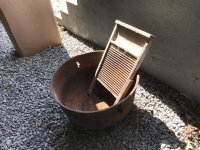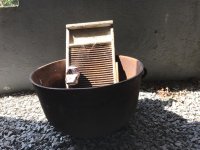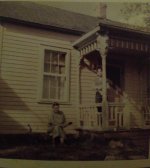rhmc24
Absent Comrade
Tough as depression times were, we were better off than a lot of people. My father had been Filling Station Manager for the Okla City area for Wirt Franklin Oil Co. but lost his job as the company failed. I was in the second grade in 1931 when we moved back to Ardmore, in with my grandparents where I was born and the same address I live today. They had gas for cooking, electricity, water and sewage. Pretty well off, had some property, owned his insurance agency, had a Model T Ford, but lived much the same as they had since the 1890s but for the utilities.
Wash day was a big thing. My grandmother would build a fire under her big black iron pot in the back yard and heat water. She and my mother washed clothes by hand on a 'wash board'. Washboards had an area a foot or so square mounted in a wood frame with legs to stand in the water in the wash tub. With soap and warm water they rubbed the dirty collars and such against the corrugated surface of the wash board to get clean. Then rinsed and wrung out the water by twisting each by hand, then hung on the clothes line. There was such a thing as a wringer with two rollers that was cranked by hand but we didn't have one. Every fall my grandmother fired up the old washpot and made lye soap - which she did till she passed in 1950.
A washing machine relieved the labor about 1932. Got a water heater also. Our new washer was the latest and greatest with the wringer 'safety release'. The rollers were powered and could be a source of injury. By hitting a bar on top the rollers separated and stopped. The common saying of getting a 'finger in the wringer' was no joke, worse if some other body part got caught.
The water heater was bare galvanized iron about a foot in diameter and five feet tall. You lit the burner below and set the flame for the water being used. With no safety devices heaters could explode if one got hot enough to make steam. Water heaters did explode - but not ours. Water usually was heated for several baths. You would put about inch and a half water in the old bathtub (standing on legs), do your bath and drain it for the next. Small children were bathed more than one at a time. We heard of grownups batheing together but didn't know anybody who would do such a bizarre thing. Probably half the houses in Ardmore didn't have a bathtub then. I recall that our house and the house next door had the bathroom added to the basic house, probably when Ardmore installed sewage, before my time.
Electric refrigerator came about 1932. Before that the ice man came each day in his horse wagon. An ice card in the window had numbers on it if, say 25 pounds, was up he put 25 in our ice box on the back porch. Horse wagon delivery also used for milk and other frequent stops. I recall person delivery, Tamale man from his pushcart sold hot tamales wrapped in corn shucks. We all ate wild game then, rabbit, squirrel, etc. These were rabbit tamales. The story went around that he was accused of using horse meat. Questioned, he admitted part horse. How much?? 50-50 - one rabbit, one horse. Such was life back in memory lane ---->
Wash day was a big thing. My grandmother would build a fire under her big black iron pot in the back yard and heat water. She and my mother washed clothes by hand on a 'wash board'. Washboards had an area a foot or so square mounted in a wood frame with legs to stand in the water in the wash tub. With soap and warm water they rubbed the dirty collars and such against the corrugated surface of the wash board to get clean. Then rinsed and wrung out the water by twisting each by hand, then hung on the clothes line. There was such a thing as a wringer with two rollers that was cranked by hand but we didn't have one. Every fall my grandmother fired up the old washpot and made lye soap - which she did till she passed in 1950.
A washing machine relieved the labor about 1932. Got a water heater also. Our new washer was the latest and greatest with the wringer 'safety release'. The rollers were powered and could be a source of injury. By hitting a bar on top the rollers separated and stopped. The common saying of getting a 'finger in the wringer' was no joke, worse if some other body part got caught.
The water heater was bare galvanized iron about a foot in diameter and five feet tall. You lit the burner below and set the flame for the water being used. With no safety devices heaters could explode if one got hot enough to make steam. Water heaters did explode - but not ours. Water usually was heated for several baths. You would put about inch and a half water in the old bathtub (standing on legs), do your bath and drain it for the next. Small children were bathed more than one at a time. We heard of grownups batheing together but didn't know anybody who would do such a bizarre thing. Probably half the houses in Ardmore didn't have a bathtub then. I recall that our house and the house next door had the bathroom added to the basic house, probably when Ardmore installed sewage, before my time.
Electric refrigerator came about 1932. Before that the ice man came each day in his horse wagon. An ice card in the window had numbers on it if, say 25 pounds, was up he put 25 in our ice box on the back porch. Horse wagon delivery also used for milk and other frequent stops. I recall person delivery, Tamale man from his pushcart sold hot tamales wrapped in corn shucks. We all ate wild game then, rabbit, squirrel, etc. These were rabbit tamales. The story went around that he was accused of using horse meat. Questioned, he admitted part horse. How much?? 50-50 - one rabbit, one horse. Such was life back in memory lane ---->



